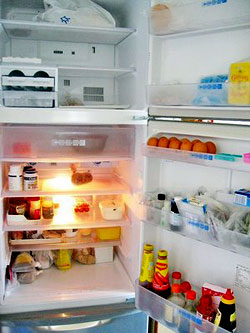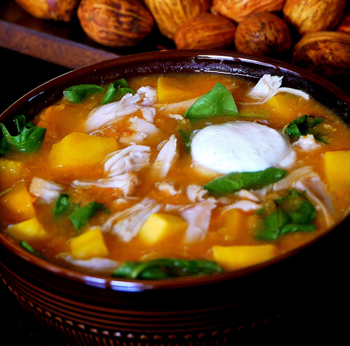 In addition to being an absolute pasta freak, I am passionate about potatoes. I could eat pasta everyday and potatoes, probably every other day. I love them every which way. A number of years ago Oprah's personal chef at the time wrote a cookbook called In the Kitchen with Rosie. It was a huge bestseller and featured very low fat recipes. There were some good recipes and techniques in the book. One of the recipes that made a big impression on me was called Mustard Roasted Potatoes.
In addition to being an absolute pasta freak, I am passionate about potatoes. I could eat pasta everyday and potatoes, probably every other day. I love them every which way. A number of years ago Oprah's personal chef at the time wrote a cookbook called In the Kitchen with Rosie. It was a huge bestseller and featured very low fat recipes. There were some good recipes and techniques in the book. One of the recipes that made a big impression on me was called Mustard Roasted Potatoes.
The Mustard Roasted Potato recipe was red potatoes tossed with Dijon mustard, cumin, paprika, chili and cayenne. The potatoes roast in the oven and become all crusty and delectable. It's a great technique and can be endlessly varied. I've incorporated plain yogurt, fresh herbs, and different kinds of mustard. I like the Moroccan mustard from Dulcet Cuisine for this recipe because it has so much flavor you don't need to add any additional spices, but feel free to experiment and try any spiced mustard you like or add some spices.
Cooking Techniques and Kitchen Gadgets
Cooking and Gadgets
My First Cookbook - A Treasury Of Great Recipes
 |
Given my love of sugar and horror, its no surprise that the first cookbook I used was by Mary and Vincent Price. It was called A Treasury of Great Recipes. Long before you had the countless husband and wife teams traveling and writing about the places they've eaten, you had Mary and Vincent Price, of all people, with photographs and anecdotes told in what is clearly Price's voice. Charming and funny, he was a wonderful raconteur and gourmand.
The first thing I made from that cookbook was an Apricot Mousse. My mother would make it and put it in these adorable little ceramic pots with lids on them and called them pot de crème. That's why, when I went to look up the recipe, I though I'd hallucinated the whole thing because that wasn’t how it was categorized in the cookbook. But it enabled me to take a walk down cookbook memory lane. It was bittersweet to gaze upon my dusty volumes of Gourmet's compendiums. So sad. But, I digress.
Wednesday Night at Chez Toi
 Wednesday was a hellish day. Because you left your
Blackberry in a restaurant the night before, you failed to remember
about the
four people coming over for dinner that evening but were conveniently
reminded
of it when you listened to your messages after coming in the door just
after 6
pm. “Really excited to see you guys tonight – what wine can we bring?”
At that moment, just when you were looking forward to watching the
Dexter episodes you missed over a leisurely dinner of re-heated pizza
and beer did reality bite you in the ass.
Wednesday was a hellish day. Because you left your
Blackberry in a restaurant the night before, you failed to remember
about the
four people coming over for dinner that evening but were conveniently
reminded
of it when you listened to your messages after coming in the door just
after 6
pm. “Really excited to see you guys tonight – what wine can we bring?”
At that moment, just when you were looking forward to watching the
Dexter episodes you missed over a leisurely dinner of re-heated pizza
and beer did reality bite you in the ass.
You realize there is no time for shopping and you will have to go with what is in the refrigerator. You also know that the only help you will get from your partner is washing up after dinner is over. You open the fridge and that cold eerie incandescent light hits you as you search each shelf – no meat but some good looking kale, scallions and an array of great condiments. And then you thank god for giving man the insight to invent freezers.
Take a Breath
 I’ve been working in the kitchen like a galley slave for the last few weeks – since before the holidays, actually, and it’s time for a parole.
I’ve been working in the kitchen like a galley slave for the last few weeks – since before the holidays, actually, and it’s time for a parole.
Don’t get me wrong, I love cooking – every aspect of it: I love schlepping the four heavy grocery bags (“Don’t forget – we need six bottles of San Pellegrino”) through the slush-filled rivers at each corner on Broadway; I love the insistent bump of the grocery cart into my Achilles tendon during the holiday rush at Fairway; I love the cutting, the chopping, the blanching, the browning. Oh God, do I have to make another battuto? I have battuto nightmares with hostile little cubes of celery coming at me brandishing Wüsthofs. I’ve got to get out of the kitchen.
Do you know battuto, by the way? It’s the Italian version of a mirapoix – onion, celery and carrot are the basics; sometimes you add parsley and sometimes even a bit of pancetta – and you cut them into small dice. A battuto is the beginning to many a good meal, the first step in recipes from pasta sauces to osso buco. A good rule to remember is that it’s always twice the volume of onion to each other veg. i.e. a half cup onions; a quarter cup carrots; a quarter cup celery; quarter cup parsley. You can’t go wrong. Put it all in a hot pan with butter and oil (or lard) and you’re off to the races.
Cooking for One
 Although accustomed to a table full of eaters, eating alone at home is no problem for me. Cooking for one, however, is. My usual repertoire for solitary meals includes either heating up leftovers or making sunny-side up eggs and toast. The meals with leftovers vary, of course, but the eggs and toast is a bit of a never-boring treasure. Now there are people I know who cook fairly extensively for themselves, but I am not one of them.
Although accustomed to a table full of eaters, eating alone at home is no problem for me. Cooking for one, however, is. My usual repertoire for solitary meals includes either heating up leftovers or making sunny-side up eggs and toast. The meals with leftovers vary, of course, but the eggs and toast is a bit of a never-boring treasure. Now there are people I know who cook fairly extensively for themselves, but I am not one of them.
My own mother was known to sit down to a fully set table and enjoy a first course of homemade soup followed by a meat, potato and vegetable main course, all topped off with a cup of brewed coffee and possibly a cookie or piece of cake, once again homemade. Not me. That much effort without the pleasure of watching someone else relish what I made, or at the least, having them eat it with no complaints is just not worth the trouble.
On one recent solo evening though, the meal I made both cracked me up and delighted me. On a lark, I spent a couple of hours baking Ina Garten’s Honey White Bread. (Barefoot Contessa at Home by Ina Garten, Honey White Bread, p. 57). As the contessa claimed, it was an easy recipe to follow, and the bread was delicious.
More Articles ...
Welcome to the new One for the Table ...
Our Home Page will be different each time you arrive.
We're sure you'll find something to pique your interest...

